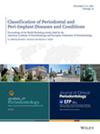Global burden of oral disorders with projections over the next 30 years.
IF 4.2
2区 医学
Q1 DENTISTRY, ORAL SURGERY & MEDICINE
引用次数: 0
Abstract
BACKGROUND This study aimed to provide an updated assessment of the global, regional, and national burden of oral disorders from 1990 to 2021, and forecast trends for the next 30 years. METHODS Data on incidence, prevalence, and disability-adjusted life years (DALYs) were extracted from the Global Burden of Diseases(GBD) 2021. The changing trends in the burden of oral disorders and subtypes were estimated using percentage change. The Nordpred model based on the age-period-cohort analysis was used to predict the burden of oral disorders over the next 30 years. RESULTS From 1990 to 2021, all oral disorders exhibited a 35.54% incidence, reaching 3.74 billion cases. Regional analysis revealed that Tropical Latin America and Southeast Asia had higher age-standardized incidence rates(ASIR). Dental caries in permanent teeth increased by 6.0% in the ASIR, while deciduous teeth caries declined by 7.83%. Periodontal disease incidence surged by 76.32% to 89.6 million cases, with discrepancies between sexes-1.05% decrease in males and a 1.14% increase in females. Edentulism incidence rose dramatically by 93.56%, totaling 26.5 million cases. Projections for the next 30 years suggest a continued rise in oral disorder cases, with the ASIR expected to rise, particularly in periodontal diseases. CONCLUSIONS The rising global burden of oral disorders, notably periodontal diseases, remains a significant public health challenge. Factors such as poor oral hygiene and disparities in healthcare access might contribute to these trends. Targeted preventive measures, including community education and alongside partnerships between researchers and policy-makers, are crucial for mitigating their impact on public health. PLAIN LANGUAGE SUMMARY Our study examines the increasing global impact of oral diseases from 1990 to 2021 and predicts their trajectory over the next 30 years. We analyzed data on how often these conditions occur and the years of healthy life lost due to them. Overall, we found that oral disorders affected an alarming 3.74 billion people by 2021, with regions like Tropical Latin America and Southeast Asia showing particularly high rates. Notably, dental cavities in adult teeth grew by 6%, while those in children's teeth declined. However, gum disease and tooth loss saw significant increases-gum disease cases shot up by over 76%, with a notable rise among women. Looking ahead, we expect more people to suffer from oral disorders, particularly gum disease. This is a serious issue for public health, possibly driven by factors like poor dental care and unequal access to services. Addressing this requires focused efforts, such as educating communities and improving access to dental care, alongside collaboration between researchers and health officials to lessen the burden of these conditions on people's lives.全球口腔疾病负担及未来30年的预测。
本研究旨在对1990年至2021年全球、区域和国家口腔疾病负担进行最新评估,并预测未来30年的趋势。方法从2021年全球疾病负担(GBD)中提取发病率、患病率和残疾调整生命年(DALYs)数据。使用百分比变化估计口腔疾病和亚型负担的变化趋势。基于年龄-时期-队列分析的Nordpred模型用于预测未来30年口腔疾病的负担。结果1990 - 2021年,我国口腔疾病发病率为35.54%,达37.4亿例。区域分析显示,热带拉丁美洲和东南亚的年龄标准化发病率(ASIR)较高。恒齿龋率上升了6.0%,乳牙龋率下降了7.83%。牙周病发病率上升76.32%至8960万例,性别差异明显,男性下降1.05%,女性增加1.14%。牙髓病发病率大幅上升93.56%,达到2650万例。对未来30年的预测表明,口腔疾病病例将继续上升,预计ASIR将上升,特别是牙周病。结论口腔疾病,尤其是牙周病的全球负担不断上升,仍然是一个重大的公共卫生挑战。口腔卫生不良和医疗保健机会不均等等因素可能导致这些趋势。有针对性的预防措施,包括社区教育以及研究人员和决策者之间的伙伴关系,对于减轻它们对公共卫生的影响至关重要。您的研究调查了1990年至2021年全球口腔疾病日益增加的影响,并预测了未来30年的发展轨迹。我们分析了这些情况发生的频率以及因此而损失的健康寿命年数的数据。总体而言,我们发现,到2021年,受口腔疾病影响的人数将达到惊人的37.4亿人,其中热带拉丁美洲和东南亚等地区的发病率尤其高。值得注意的是,成人牙齿的蛀牙增加了6%,而儿童牙齿的蛀牙减少了。然而,牙龈疾病和牙齿脱落的病例显著增加——牙龈疾病病例飙升了76%以上,其中女性的增幅明显。展望未来,我们预计会有更多的人患有口腔疾病,特别是牙龈疾病。这是公共卫生方面的一个严重问题,可能是由于牙科保健差和获得服务的机会不平等等因素造成的。解决这一问题需要集中努力,例如教育社区和改善获得牙科保健的机会,同时研究人员和卫生官员之间进行合作,以减轻这些疾病对人们生活的负担。
本文章由计算机程序翻译,如有差异,请以英文原文为准。
求助全文
约1分钟内获得全文
求助全文
来源期刊

Journal of periodontology
医学-牙科与口腔外科
CiteScore
9.10
自引率
7.00%
发文量
290
审稿时长
3-8 weeks
期刊介绍:
The Journal of Periodontology publishes articles relevant to the science and practice of periodontics and related areas.
 求助内容:
求助内容: 应助结果提醒方式:
应助结果提醒方式:


